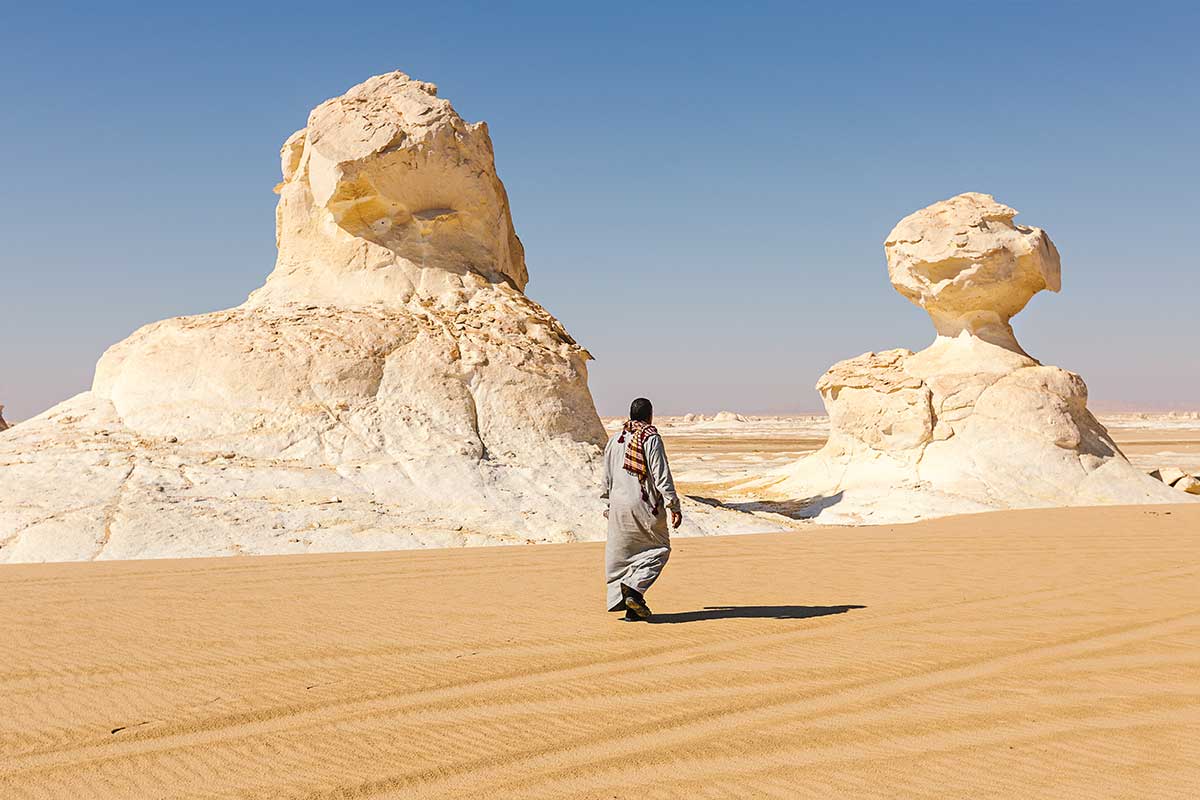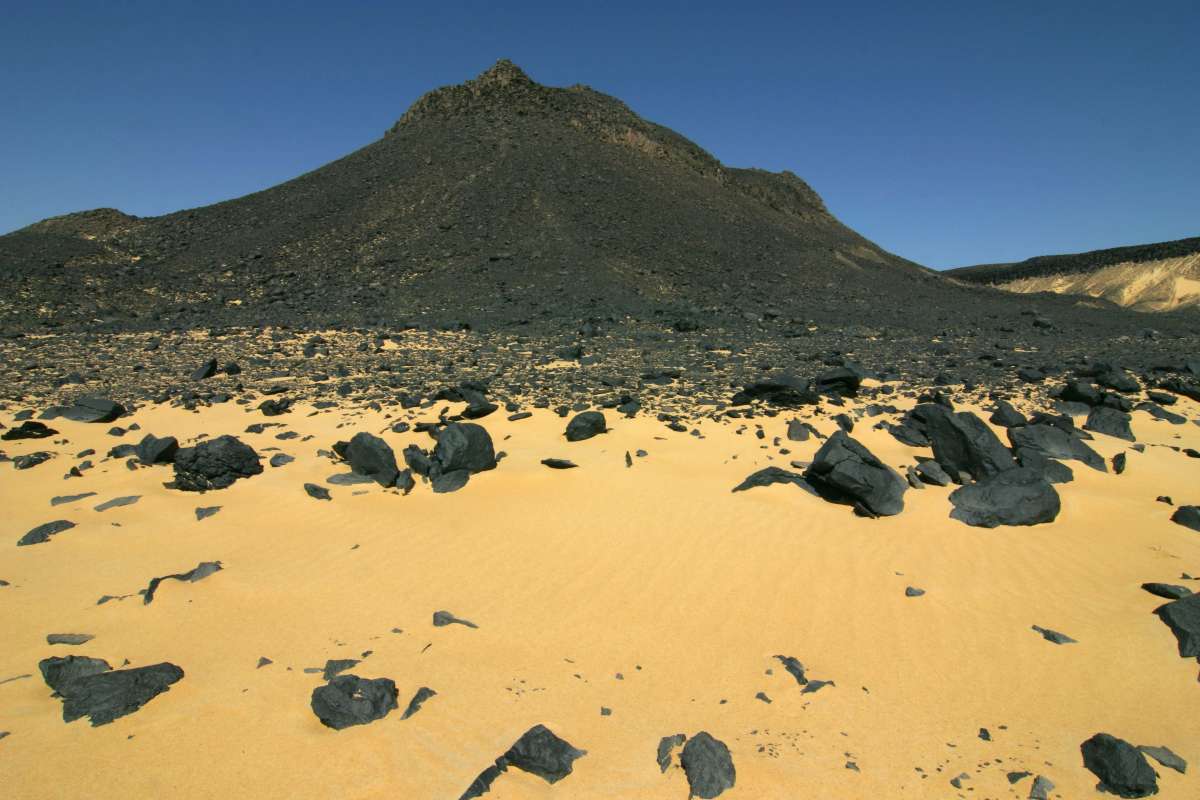Because it is the closest to Cairo, because of the recent discoveries from the Pharaonic era, and because it is the best base for unforgettable excursions through the Western Desert, the Bahariya Oasis has become a favorite for travelers. On this page, we tell you everything you need to know if you are planning to visit it. And we remind you that you can put yourself in the hands of Egipto Exclusivo to plan even the smallest detail. Leave nothing to chance to fully enjoy your experience!
The Bahariya Oasis is located in the Western Desert, about 200 km west of the Nile Valley and about 370 km by road from Cairo. Taking the capital as a reference, it is the closest, if we exclude the El Fayum Oasis from the list, which, due to its geographical particularities, is practically integrated into the Nile Valley. Administratively, it belongs to the Giza Governorate.
The Bahariya Oasis is actually made up of several small towns located close to each other, where its inhabitants exploit the agricultural possibilities offered by the land. It is worth mentioning Bawiti (the main one of all, with a population of several tens of thousands of inhabitants), El-Harra, and Bahariya, which gives its name to the oasis because it is the closest to the small body of water that emerges here. In addition to agriculture and tourism, mining is another current economic activity, dedicated to the extraction of iron.

Although currently the populations of the Bahariya Oasis have a very humble character, this place enjoyed great prosperity in the past, especially in Greco-Roman times. Taking as a reference the magnitude of the necropolis discovered a decade ago, experts estimate that about 500,000 people could have lived here, although this is a very difficult calculation to make. At that time, local crops provided abundant wheat and wine for the populations of the Nile Valley, and the area had an important defensive fortress.
However, the strategic location of the Bahariya Oasis on the caravan routes meant that its emergence and development were much earlier. In various archaeological campaigns, fragments of stone with inscriptions datable to the Old Kingdom and the Middle Kingdom were found. In addition, we can mention other illustrious inhabitants of the Bahariya Oasis from a much earlier time, when it was not even an oasis: the dinosaurs. Findings from the 1930s led to a species of megaraptorid theropod being named Bahariasaurus. It lived here in the Cretaceous period, about 95 million years ago.
At first glance, the Bahariya Oasis does not generate a great visual impact, as can happen, for example, in Siwa. Here, there are no large ruins from ancient times, nor such exuberant vegetation. But by ‘scratching’ a little, some discoveries worthy of being known appear. We will tell you about them below. .
Undoubtedly, the discovery of the Valley of the Golden Mummies was a boost for tourism in the Bahariya Oasis. It is its great attraction, both for its uniqueness and its mysterious beauty. The mummies and their sarcophagi, some with gold masks and rich jewelry, were found in a necropolis about 6 km from Bawiti. Among them, that of the local governor Jed Khenso Ifuankh.
Although the vast majority of what was discovered is not open to the public, some mummies and sarcophagi have been selected to be part of the Golden Mummies Hall, the main museum in the city of Bawiti. Here you can see how these funerary works of art, datable to the Greco-Roman period, have a style of transition between the rigid forms of Ancient Egypt and the more realistic ones of the ‘El Fayum portraits’.
In the Bahariya Oasis there are also ancient archaeological remains and, although they are not as spectacular as those of other sites in the country, they will be interesting for fans of Egyptology. Of particular note, for example, are the remains of a temple dedicated to Alexander the Great, the only one in the whole country. The veneration of pharaohs was a common practice in all eras of Ancient Egypt and this Macedonian emperor, who adopted such a title upon his arrival in the country, was no stranger to it. The reason why it was erected in this location is not clear, although it is believed that he may have passed through the Bahariya Oasis on his return from his visit to the Siwa oracle, which may have provoked that desire among its people.
The other ancient temple that has been discovered in the Bahariya Oasis is one dedicated to Amun-Ra, datable to the time of the XXVI Dynasty, precisely the same period as that of the necropolis of the Golden Mummies.
There is no doubt that many people are encouraged to travel to the Bahariya Oasis with their minds set on its excursions. From here it is possible to travel to some of the most fascinating places left to us by the Western Desert, which can be reached by 4×4.

As can be deduced from its name, this is an area of the desert full of rock formations that have a surprising white color, as its composition is a mixture of limestone and chalk. For greater magic, the daylight modifies its tonality according to the time and the period of the year. You will find it on the road that connects the Bahariya Oasis with that of Farafra, about 100 km south of Bawiti.
Although for surprising, the capricious shape that many of them have, the result of thousands and thousands of years of erosion. There are many types, with shapes that the imagination of each traveler will interpret as they please. An example is that of the Bedouins, who gave it the name of ‘Valley of the Carrots’ because that is how they interpreted the silhouette of many rocky pinnacles in the place. So it will not be strange to see, petrified, rocks that look like camels, sphinxes, mushrooms, birds…

Curiously, the White Desert has its counterpoint. And it is not far from the Bahariya Oasis, about 50 km south of the town of Bawiti. We are talking about the Black Desert, which also takes this name from the predominant color in its rock formations. But in this case, of a very different nature: dolerite, an igneous rock expelled by volcanic mountains that erupt.
That is precisely what happened here a long time ago, because the Western Desert has numerous volcanic mountains that are already inactive. These eruptions covered the area with this type of black rock , which due to erosion has given rise to the characteristic hills that you will see here, where its dark hue mixes with the golden color of the desert sand. You can climb some of them to see a spectacular panoramic view of the Black Desert and beyond, for example from the English Mountain.

This is another of the classic excursions that are made from the Bahariya Oasis, although it can also be done from the Farafra Oasis. It is located about 90 km south of Bawiti, precisely between the White Desert and the Black Desert, with indications on the only road in the area.
This suggestive name refers to a rocky promontory formed mainly of quartz crystal, which gives it that bright and almost transparent appearance. This is a very unique example because normally these formations remain underground in the form of a cave. And it may have been so originally, when this was not an arid desert but a more fertile and humid terrain. But with the gradual withdrawal of water, the crystals probably grew towards the surface, being exposed by the effect of erosion. Therefore, some dare to call it an ‘exhumed cave’, a fairly graphic term for what could have been the history of this surprising natural accident located in the surroundings of the Bahariya Oasis.
Despite the fact that the Bahariya Oasis is located, in a straight line, about 200 km east of the Nile Valley, at the height of what is often known as Middle Egypt, there is no direct road connection with that area. Therefore, given the logical absence of airports, train stations, waterways for cruises, and regular bus lines, the only solution to get here is a private vehicle from Cairo (see here how to get to Cairo).
As we said above, the Bahariya Oasis is located about 370 km by road from the capital. And that, in time, translates into almost 4 and a half hours of travel on the road known as El Wahat Road, paved and relatively well maintained due to the existence of some scattered industrial facilities along the way.
Therefore, having a private vehicle with a driver is essential, not only for comfort, but also for general safety: the distances in the desert are immense and the conditions are extreme, so traveling autonomously is not the most recommended because any mishap can be aggravated in the absence of company.
So if you have decided to travel to the Bahariya Oasis from Cairo or as part of a circuit through the different oases of Egypt, do not hesitate to contact Egipto Exclusivo. We will give you the service and support you need to make this adventure as exciting and enriching as possible , but in no case risky. Contact us now!

